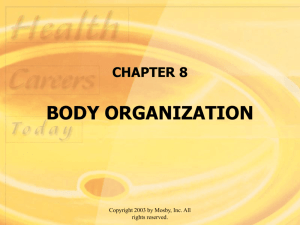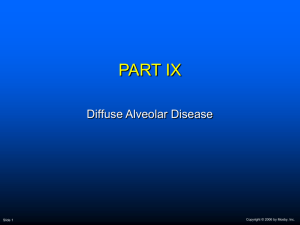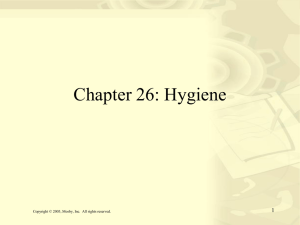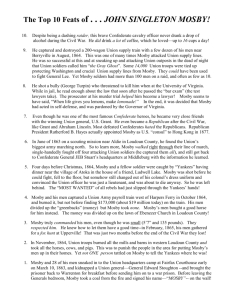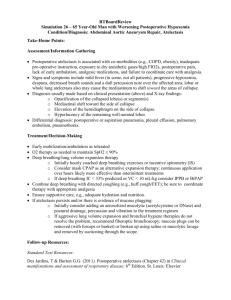Chapter_044_Post-Op_atelectasis
advertisement
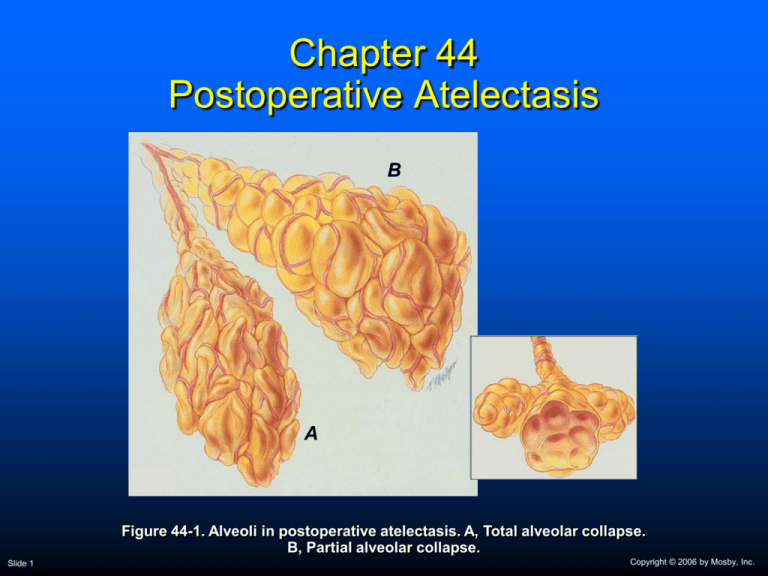
Chapter 44 Postoperative Atelectasis B A B A Figure 44-1. Alveoli in postoperative atelectasis. A, Total alveolar collapse. B, Partial alveolar collapse. Slide 1 Copyright © 2006 by Mosby, Inc. Anatomic Alterations of the Lungs Slide 2 Alveoli of primary lobules (micro-atelectasis or subsegmental atelectasis)—very common Lung segment—fairly common Lung lobe—less common Entire lung—rare Copyright © 2006 by Mosby, Inc. Etiology Decreased Lung Expansion Thoracic and upper abdominal procedures Slide 3 Considered high risk for atelectasis Copyright © 2006 by Mosby, Inc. Etiology Decreased Lung Expansion Other precipitating factors Anesthesia Postoperative pain Supine position Obesity Advanced age Inadequate tidal volumes during mechanical ventilation Malnutrition Ascites Diaphragmatic apraxia The presence of a restrictive lung disorders Slide 4 Copyright © 2006 by Mosby, Inc. Etiology Alveolar Degassing Atelectasis associated with airway secretions and mucus plugs Slide 5 Precipitating factors Decreased mucociliary transport Excessive secretions Inadequate hydration Weak or absent cough General anesthesia Smoking history Gastric aspiration Certain preexisting conditions (e.g., chronic bronchitis, asthma) Copyright © 2006 by Mosby, Inc. Overview of the Cardiopulmonary Clinical Manifestations Associated with POSTOPERATIVE ATELECTASIS The following clinical manifestations result from the pathophysiologic mechanisms caused (or activated) by Atelectasis (see Figure 9-7)—the major anatomic alterations of the lungs associated with postoperative atelectasis (see Figure 44-1) Slide 6 Copyright © 2006 by Mosby, Inc. Figure 9-7. Atelectasis clinical scenario. Slide 7 Copyright © 2006 by Mosby, Inc. Clinical Data Obtained at the Patient’s Bedside Vital signs Slide 8 Increased respiratory rate Increased heart rate, cardiac output, blood pressure Copyright © 2006 by Mosby, Inc. Clinical Data Obtained at the Patient’s Bedside Slide 9 Cyanosis Cough, sputum production, and hemoptysis Chest assessment findings Increased tactile and vocal fremitus Dull percussion note Bronchial breath sounds Diminished breath sounds (when mucus plugs present) Crackles Whispered pectoriloquy Copyright © 2006 by Mosby, Inc. Figure 2-11. A short, dull, or flat percussion note is typically produced over areas of alveolar consolidation. Slide 10 Copyright © 2006 by Mosby, Inc. Figure 2-16. Auscultation of bronchial breath sounds over a consolidated lung unit. Slide 11 Copyright © 2006 by Mosby, Inc. Figure 2-19. Whispered voice sounds auscultated over a normal lung are usually faint and unintelligible. Slide 12 Copyright © 2006 by Mosby, Inc. Clinical Data Obtained from Laboratory Tests and Special Procedures Slide 13 Copyright © 2006 by Mosby, Inc. Pulmonary Function Study: Expiratory Maneuver Findings FVC FEVT N or FEF25%-75% N or FEF200-1200 N PEFR MVV FEF50% FEV1% N Slide 14 N or N N or Copyright © 2006 by Mosby, Inc. Pulmonary Function Study: Lung Volume and Capacity Findings VT Slide 15 RV FRC TLC N or VC IC ERV RV/TLC% N Copyright © 2006 by Mosby, Inc. Arterial Blood Gases Small or Localized Postoperative Atelectasis Acute alveolar hyperventilation with hypoxemia pH Slide 16 PaCO2 HCO3 (Slightly) PaO2 Copyright © 2006 by Mosby, Inc. Time and Progression of Disease Disease Onset Alveolar Hyperventilation 100 90 PaO2 or PaCO2 80 Point at which PaO2 declines enough to stimulate peripheral oxygen receptors 70 60 PaO2 50 40 30 20 10 0 Figure 4-2. PaO2 and PaCO2 trends during acute alveolar hyperventilation. Slide 17 Copyright © 2006 by Mosby, Inc. Arterial Blood Gases Widespread Postoperative Atelectasis Acute ventilatory failure with hypoxemia pH Slide 18 PaCO2 HCO3 (Slightly) PaO2 Copyright © 2006 by Mosby, Inc. Time and Progression of Disease Disease Onset Alveolar Hyperventilation Acute Ventilatory Failure 100 90 80 70 Point at which PaO2 declines enough to stimulate peripheral oxygen receptors Point at which disease becomes severe and patient begins to become fatigued 60 50 40 30 20 10 0 Figure 4-7. PaO2 and PaCO2 trends during acute ventilatory failure. Slide 19 Copyright © 2006 by Mosby, Inc. Oxygenation Indices QS/QT DO2 VO2 Normal O2ER Slide 20 C(a-v)O2 Normal SvO2 Copyright © 2006 by Mosby, Inc. Radiologic Findings Chest radiograph Slide 21 Increased density in areas of atelectasis Air bronchograms Elevation of the hemidiaphragm on the affected side Mediastinal shift toward the affected side Copyright © 2006 by Mosby, Inc. General Management of Postoperative Atelectasis Precipitating factors for postoperative atelectasis should be identified High-risk patients should be monitored closely Preventive measures should be prescribed for high-risk patients Slide 22 Incentive spirometry Chest physical therapy Whenever possible, treatment of the underlying cause of atelectasis should be prescribed immediately Copyright © 2006 by Mosby, Inc. General Management of Postoperative Atelectasis Respiratory care treatment protocols Slide 23 Oxygen therapy protocol Bronchopulmonary hygiene therapy protocol Hyperinflation therapy protocol Mechanical ventilation protocol Copyright © 2006 by Mosby, Inc.


